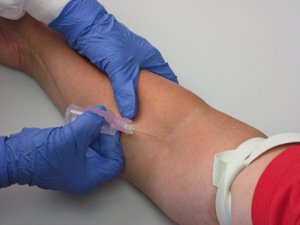Eight Questions Every Phlebotomist MUST Answer Correctly: #1
Do you know the limits to needle relocation?
by Dennis Ernst • January 21, 2021
One of our most popular downloads is "Eight Questions Every Phlebotomist Must Answer Correctly." It occurs to me they would also be excellent blog posts, too. So I'll post each question and the correct answer here one at a time.

Question #1: Do you know the limits to needle relocation?
Even the best don't access the vein immediately upon needle insertion. What you do when you miss a vein can make the difference between a successful venipuncture and a permanently disabled patient. It's all about the antecubital anatomy.
Properly trained specimen collection personnel know where the brachial artery and nerves pass through the antecubital area. (Editor's note: A poster depicting the anatomy of the antecubital area is available from the Center for Phlebotomy Education.) They realize how easy they can be injured when a needle is relocated where the nerves are. So when they miss, they limit their relocation to either forward or reverse movements, and will not attempt any side-to-side repositioning.
A beveled needle is like a scalpel; when it’s moved around beneath the skin, it slices everything it comes in contact with. Before deciding to relocate a needle that has missed a vein, a key passage from the Clinical and Laboratory Standards Institute's (CLSI) venipuncture standard should come to mind. It limits needle relocation to advancing the needle or withdrawing it slightly. Probing blindly is never permitted. Nor is a sideways relocation acceptable in the medial aspect of the antecubital area, i.e., where nerves and the brachial artery are in close proximity.
Whenever attempting to relocate a needle, be aware of the risks involved before making the decision. You must have a high degree of confidence that the vein can be accessed safely and successfully before proceeding; this requires a thorough knowledge of the standards and the anatomy of the antecubital area. Discontinuing the attempt might delay you a few more minutes while you attempt to access a vein elsewhere, but trying to aggressively salvage the puncture could lead to years of pain, anxiety, and litigation for you and your patient.
Correct answer: The limit to needle relocation when the vein is missed on initial insertion is to advance the needle farther toward the vein, or to withdraw it slightly backward. Needles should never be moved side-to-side when attempting to access the medial aspect of the antecubital area. Blindly probing should never be attempted on any vein.
Related Posts and Information
overall rating: my rating: log in to rate
needle nerve injury probe probing relocation
30 Comments
needle reloction is limited
never move needle side to side after missing a vein, either move needle forward or backwards towards the vein for a successful draw.
doreen beasley, 03/20/2021 17:46:30
sideways movement
Good point, but CLSI allows sideways needle relocation as long as it's calculated (i.e., no blindly probing), and not in the area of the brachial artery and median nerves.
Dennis Ernst, 03/22/2021 08:26:07
